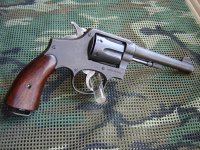Regarding the finish, by late 1941, the pre-war civilian blued finish was replaced by a sandblast (so-called brush blue) blued finish to speed up production. That lasted only a few months, and was replaced by a phosphate finish (Parkerizing) by early-mid 1942 which was not a bluing at all, and speeded up production even more. Virtually all US WWII small arms were given a phosphate finish - M1, M1 Carbine, M1911A1 .45, BAR, M1903A3, etc., as wartime production needs would not allow bluing. The British speeded up things even more, and just spray painted much of their small arms production.












